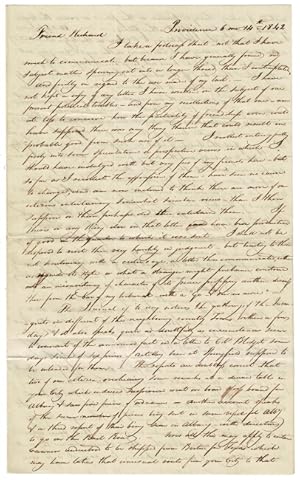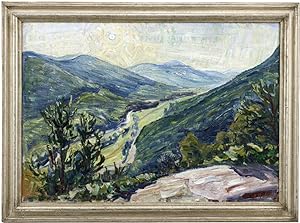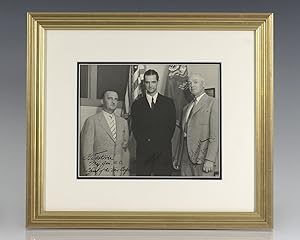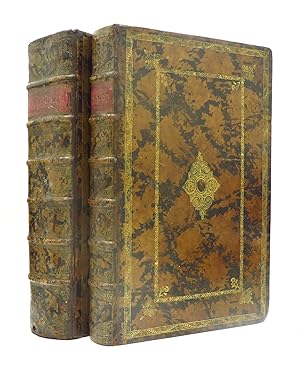Arnold (Over 293,000 results)
Product Type
- All Product Types
- Books (291,049)
- Magazines & Periodicals (730)
- Comics (130)
- Sheet Music (800)
- Art, Prints & Posters (504)
- Photographs (66)
- Maps (10)
-
Manuscripts &
Paper Collectibles (465)
Condition
Binding
Collectible Attributes
- First Edition (22,010)
- Signed (3,394)
- Dust Jacket (18,578)
- Seller-Supplied Images (82,396)
- Not Printed On Demand (250,080)
Free Shipping
Seller Location
Seller Rating
-
Anekdota zur neuesten deutschen Philosophie und Publicistik von Bruno Bauer, Ludwig Feuerbach, Friedrich Köppen, Karl Nauwerk, Arnold Ruge und einigen Ungenannten.
Published by Zürich & Winterthur, Verlag des Literarischen Comptoirs, 1843., 1843
Seller: Antiquariat INLIBRIS Gilhofer Nfg. GmbH, Vienna, A, Austria
First Edition
8vo. 2 vols. in one. IV, 320 pp. IV, 288 pp. Modern half calf. First edition, comprising both volumes. Contains Marx's first political pamphlet, the anonymous "Bemerkungen über die neueste preußische Censurinstruction. Von einem Rheinländer" (in vol. I, p. 56-88). Another anonymous essay, "Luther als Schiedsrichter zwischen Strauß und Feuerbach" (II, 206-208), has also been attributed to Marx, though Feuerbach may also have been the author of this brief piece. - Marx had sent Ruge his manuscript of the "Bemerkungen" from Trier on 10 February 1842 as a submission to the "Deutsche Jahrbücher", asking him for the time being not to reveal the author's identity to anyone save the publisher. Indeed, the essay was not published there, but in Ruge's present collection of "Anekdota", printed in Switzerland and comprising such contributions as either had been not admitted by the Saxon censorship or which he had not even bothered to submit. - Published in January 1843, the "Anekdota" appeared at the very moment when the liberal, democratic-leaning German press was particularly vigorously suppressed. The book struck a sensational blow against the pettily bureaucratic, reactionary censorship in the German countries by unmasking specifically the Prussian and Saxon censors' bias against all progressive scholarship and writing (cf. I. Taubert/W. Schuffenhauer, Marx oder Feuerbach?, in: Beiträge zur Marx-Engels-Forschung [1975], p. 37). - Contemporary Viennese ownership stamp to title page. Occasional slight foxing, but a very good copy altogether. - Rubel 27 & 28. Stammhammer II, 10. Friedlaender 35. MEGA I.1, 151-175.
-
Original typed unpublished manuscript by Arnold Samuelson about his fishing trip in Cuba and Key West with Ernest Hemingway, extensively edited in Hemingway's hand. Hemingway's pencil annotations and corrections consist of over 650 words, from a single word on one page to 172 words on another, plus typing corrections, deletions, and other markings. Hemingway rewrote portions of the manuscript and added a number of original sentences.
Published by N.p.,, 1934
Seller: Jeffrey H. Marks, Rare Books, ABAA, Rochester, NY, U.S.A.
14 leaves (of which five have text on both sides). 11 x 8-1/2 inches, preserved in a custom folding box. Light dampstain to some leaves (not affecting legibility); edges of a few leaves chipped (not affecting text). With a copy of Arnold Samuelson's "With Hemingway: A Year in Key West and Cuba" (New York: Random House, [1984), detailing how Hemingway came to edit and revise this typescript.
-
Lighting Colom of the Midland-Sea, Containing a Description of all the knowne Coast, Islands, Sands, Depthes, and Roads, begining from the narrowest, of the Streat, unto Alexandrette in the Levant.
Published by By Arnold Colom, for John Tuthill, Book-seller in Great Yarmouth, and to be sold by Severall, Bookesellers in London,, Amsterdam,, 1660
Seller: Daniel Crouch Rare Books Ltd, London, United Kingdom
Book
Rare English edition of Colom's Mediterranean Sea pilot Folio (420 by 375mm), engraved title, nineteen double-page engraved charts, numerous woodcut charts and coastal profiles within text, contemporary English panelled calf, rebacked. Arnold Colom, the son of Jacob Colom, was, like his father, a bookseller, printer, and chartmaker. He would appear to have produced only two maritime atlases throughout his career: a pilot of the Mediterranean, and a sea atlas of the world. The reasons for this are unclear, although, with the market so dominated by the likes of Janssonius, Goos, and Doncker, his work might have struggled to secure a foothold. Both Arnold and his father Jacob, produced pilots of the Mediterranean. However, when Arnold published his pilot in 1660 he chose not to reuse his father's copper plates, instead cutting new plates at the behest of John Tuthill, an English bookseller from Yarmouth. The contract that they signed survives, and states that Colom was to deliver 500 Strait-books unbound to John Tuthill at 45 pennies a piece; one hundred of which were to be sold by Colom. A penalty of 500 guilders was set out for both parties if the contract was breached: Tuthill for commissioning another chartseller to produce a Straitsbook; and Colom for printing more than the agreed amount. The work was to be sold for no less than six guilders for the period of the 12 year contract. A notary act of 1664 goes into some detail regarding the originality of Colom's Mediterranean pilot. Arnold states that his father, Jacob, had previously supplied Tuthill with pilots of the Mediterranean. However, when Jacob was contacted by Tuthill in 1660, he was unable to fulfil the order and referred Tuthill to his son, who agreed to cut new plates and provide a new translation of the text. Rare. Koeman records only three institutional examples of this edition: the Bodleian Library; the National Maritime Museum; and the Admiralty Library, Portsmouth. Koeman, IV, A. Col 4.
-
Libro Historia Social De La Literatura Y El Arte 1 - Hauser,
Published by DEBOLS!LLO, 2022
ISBN 10: 9877254859ISBN 13: 9789877254853
Seller: Juanpebooks, MIAMI, FL, U.S.A.
Book
Condition: New. Libro nuevo, sellado, fisico, original. Enviamos a todos el mundo por USPS, Fedex y DHL. 100% garantia en su compra. Sealed, new. Unopened. 100%guarentee. We ship worldwide.
-
Libro Historia Social De La Literatura Y El Arte 1 - Hauser,
Published by DEBOLS!LLO, 2022
ISBN 10: 9877254859ISBN 13: 9789877254853
Seller: Juanpebooks, MIAMI, FL, U.S.A.
Book
Condition: New. Libro nuevo, sellado, fisico, original. Enviamos a todos el mundo por USPS, Fedex y DHL. 100% garantia en su compra. Sealed, new. Unopened. 100%guarentee. We ship worldwide.
-
Libro Historia Social De La Literatura Y El Arte 1 - Hauser,
Published by DEBOLS!LLO, 2022
ISBN 10: 9877254859ISBN 13: 9789877254853
Seller: Juanpebooks, MIAMI, FL, U.S.A.
Book
Condition: New. Libro nuevo, sellado, fisico, original. Enviamos a todos el mundo por USPS, Fedex y DHL. 100% garantia en su compra. Sealed, new. Unopened. 100%guarentee. We ship worldwide.
-
IOANNIS // BAPTISTAE // PIRANESII // ANTIQVARIORVM // REGIAE ^ SOCIETATIS // LONDINENSIS // SOCII // CAMPVS MARTIVS // ANTIQVAE // VRBIS // ROMAE. MDCCLXII // ROBERTO // ADAM // BRITANNO // ARCHITECTO // CELEBERRIMO // Veneunt apud Auctorem in aedibus Comitis Thomati via Felici prope templum SS. Trinitatis in Monte Pincio. // Piranesi F. (Ioannis Baptistae Piranesii Antiquariorum Regiae Societatis Londinensis socii Campus Martius antiquae vrbis = [Il Campo Marzio dell'antica Roma : opera / di G.B. Piranesi].).
Published by Veneunt apud Auctorem in ædibus Comitis Thomati via Felice prope templum SS. Trinitatis in Monte Pincio; c.1762, Romae, 1762
Seller: Alexandre Antique Prints, Maps & Books, Toronto, ON, Canada
Signed
Contemporary half calf; double gilt fillets bordering marbled boards; spine with five (5) matching gilt fillets on raised bands, embossed gilt lettered title on two and four; pasted and free endpapers marbled; all edges marbled., Text in Latin and Italian.This work was dedicated by Piranesi to one of his highly esteemed co-workers (during the 1750?s), Robert Adam. Concerning this Rome, 1762 edition, Luigi Ficacci states: ?Edition Rome 1762. Engraved title on the title page: The Campus Martius of Ancient Rome, the Work of G. B. Piranesi, Fellow of the Royal Society of Antiquaries, London. The Latin title page bears the title, the date of the edition, and the dedication to Robert Adam. The address is: ?Veneunt apud Auctorem in aedibus Comitis Thomati via Felice prope Templum SS. Trinitatis in Monte Pincio?.The volume is composed of 2 title pages (Latin and Italian, whose sequence varies according to the copy), 2 ornamented letters, 4 vignettes, 42 plates by Piranesi (5 of these plates are composed of several copperplates), and 1 engraved by Vesterhout*, 68 pages of text in Italian and Latin, preceded by 6 pages of dedication to Robert Adam and followed by 29 pages of indices. ?The genesis of the work goes back to the second half of the 1750s: its publication is announced as imminent in the first volume of Antichita Romane (1756). The large Plan of Campo Marzio and 6 copperplates (?Ichnographia? or plan of the Campus Martius, ill. 493), executed in collaboration with Robert Adam and dedicated to him, is dated 1757 on the plate. The approbatio is dated 1761. The plate by Vesterhout (plate XXXI, ?) reproduces the technical solution adopted by Carlo and Francesco Fontana for restoration of the Column of Antonius Pius in 1705.?*Plate XXXI, depicting the excavation of the Antonine column in 1705, was signed by both, its engraver, Arnold Van Westerhout or Vesterhout, and by its designer and artist, Franciscus Fontana. The second illustrated title or title in Italian reads: 'Il Campo Marzio Dell'Antica Roma'., Size : Folio (542 x 406mm)., Copper engravings with illustrated title in Latin, illustrated title in Italian, two half-page head-piece vignettes opening dedication at a1v-2r; two engraved decorative copper initials opening the text at A1v and A2r; two large end-piece vignettes at R2v, and R3r; moreover, Tab. I-XLVIII with fifty-two (52) copper engraved plates; these include: a double-page plate numbered XXXII, two triple or oversized folding plates numbered II and XXXI; a larger oversized engraving (1500x1500mm) encompassing plates V-X forming the plan of the Campus Martius; a single page numbered XLVIII, depicting three copper plates, entitled ?Elevazione de? Teatri?? , ?Elevazione del Pantheon?? and ?Elevazione dell? Anfiteatro?; single pages two [half-page] copper plates each - numbered XII (entitled ?Hypsographia?? and ?Sectio??) and XLVI (entitled ?A Reliquiae?? and ?Orthographia??) respectively; the remaining copper plates full or single page sized. , Upper marginal corner of upper pasted endpaper with sticker reading ?C.E.Rappaport // Libri Rari // Roma?- , References : Luigi Ficacci, pp. 394-431; Focillon (1964): 428-479; Hind (1978): 85; Millard iv (2000): 91; RIBA, Early Pr. iii (1999): 2551; Wilton-Ely (1994): 559-612. , Ll: Bl. (2), Illustrated title in Latin, illustrated title in Italian, a1-b2 (with dedication), A1-Q2, R1-3 (with approbation and explanatory texts); a1-c2 (with Index) ; *1-***2, ****1-3 (with catalogues); [illustrations: Tab.I-XLVIII]; bl. (2). Fine thick laid 18th century Italian paper with wide margined paper watermarked engravings; spine and corners worn ? A handsome and attractive example, plates are clean and crisp.
-
IOANNIS // BAPTISTAE // PIRANESII // ANTIQVARIORVM // REGIAE ^ SOCIETATIS // LONDINENSIS // SOCII // CAMPVS MARTIVS // ANTIQVAE // VRBIS // ROMAE < MDCCLXII // ROBERTO // ADAM // BRITANNO // ARCHITECTO // CELEBERRIMO // Veneunt apud Auctorem in aedibus Comitis Thomati via Felici prope templum SS. Trinitatis in Monte Pincio. // Piranesi F.
Published by Veneunt apud Auctorem in ædibus Comitis Thomati via Felice prope templum SS. Trinitatis in Monte Pincio; [ watermarks indicate:] c.1770?s-1790?s, Romae/Rome, 1770
Seller: Alexandre Antique Prints, Maps & Books, Toronto, ON, Canada
Signed
Contemporary half calf with marbled boards; spine with five (5) blind raised bands, flanked by gilt tooling; gilt lettered title on Morocco label on two; contemporary pasted and free endpapers; all edges speckled red., Text in Italian; captions in Latin.This work was dedicated by Piranesi to one of his highly esteemed co-workers (during the 1750?s), Robert Adam. Concerning the Rome 1762 edition, Luigi Ficacci states: ?Edition Rome 1762. Engraved title on the title page: The Campus Martius of Ancient Rome, the Work of G. B. Piranesi, Fellow of the Royal Society of Antiquaries, London. The Latin title page bears the title, the date of the edition, and the dedication to Robert Adam. The address is: ?Veneunt apud Auctorem in aedibus Comitis Thomati via Felice prope Templum SS. Trinitatis in Monte Pincio?.The genesis of the work goes back to the second half of the 1750s: its publication is announced as imminent in the first volume of Antichita Romane (1756). The large Plan of Campo Marzio and 6 copperplates (?Ichnographia? or plan of the Campus Martius, ill. 493), executed in collaboration with Robert Adam and dedicated to him, is dated 1757 on the plate. The approbatio is dated 1761. The plate by Vesterhout (plate XXXI, ?) reproduces the technical solution adopted by Carlo and Francesco Fontana for restoration of the Column of Antonius Pius in 1705.?, Size : Folio (542x406mm). , Etched copper engravings with illustrated title in Latin, illustrated title in Italian, ornamental head-piece and engraved decorative copper initial at A1r; the initial opens the text. Tab. I-XLVIII, plus three full page engravings entitled ?Sepulchrum Mariae Honorij Imp. Uxoris ??, ?Labrum aegyptiacum porphyreticum??, and Nonnulla monumenta sepulcralia, quae recensentur??; these 51etchings include double-page plates numbered V-X forming the plan of the Campus Martius and one double page plate # XXXII; two triple or oversized folding plates numbered II and XXXI; a single page numbered XLVIII depicting three copper plates, entitled ?Elevazione de? Teatri?? , ?Elevazione del Pantheon?? and ?Elevazione dell? Anfiteatro?; single pages two [half-page] copper plates each - numbered XII (entitled ?Hypsographia?? and ?Sectio??) and XLVI (entitled ?A Reliquiae?? and ?Orthographia??) respectively; the remaining copper plates are full page in size. Plate XXXI was engraved by Vesterhout* after Fontana.Thick, wide margined paper; many watermarks, pointing this Roman edition to the time frame of 1770?s -1790?s. Examples of watermarks: an unlisted on both free endpapers with an inner fleur de lis design within a circle; #19 (1790?s) at plate 43; #68 (probably 1790?s) at plate 35; #59 (mid 1770?s -1790?s) at plates 31 and 32; #64 (1790?s) also on plate 31; # 12 (late 1780?s -1790?s) at plate 30; #14 (mid 1761) or #16 (1790?s) at plate 29; #59 (mid 1770?s -1790?s) and 64 (1790?s) at insert plate 21 entitled Scenographia Machinae qua Clemente XI. Pont. Max. An. D. MDCCV; #74 (1790?s) on unnumbered plate entitled ?Sepulchrum Mariae Honorij Imp. Uxoris? generally featured as headpiece vignette of the Latin text.; #12 (late 1780?s -1790?s) on unnumbered plate, entitled ?Labrum aegyptiacum porphyreticum??, here as full plate, otherwise a headpiece of the Latin text. *Plate XXXI, depicting the excavation of the Antonine column in 1705, was signed by both, its engraver, Arnold Van Westerhout or Vesterhout, and by its designer and artist, Franciscus Fontana. The second illustrated title or title in Italian reads: 'Il Campo Marzio Dell'Antica Roma'., References : Luigi Ficacci, pp. 394-431; Focillon (1964): 428-479; Hind (1978): 85; Millard iv (2000): 91; RIBA, Early Pr. iii (1999): 2551; Wilton-Ely (1994): plates 559-612. , Ll: Bl., Illustrated title in Latin, A1-H2, a1-c2 (with catalogue and indices); illustrated title in Italian; Tab.I-XLVIII plus three full-leaf unnumbered plates, bl. Plates and text crisp and clean, near fine. Thick, wide margined paper.
-
SIGNALS. Ri;gas Tautas augstskolas audzeknu socialistisks zurnals visiem, kas macas.
Published by Riga: Tautas augstskola, 1928-1930, 1928
Seller: Michael Fagan Fine Art & Rare Books, Newton, MA, U.S.A.
Magazine / Periodical First Edition
Soft cover. Condition: Fine. 1st Edition. October 1928-July 1930 (all published) Octavo, wrappers, 19 numbers in 17 issues. From its first issue stating its intent as a Marxist journal of the social sciences and arts, Signals was, like almost all avant-garde activities in Latvia, driven by a social and economic agenda which incorporated the use modernist graphic design of the day. There are, among the more generally Soviet leaning essays and reviews, some interesting original wood- and linocuts and photo-collages, but the most striking aspect is the cover design, unique to each issue, which were highly original Constructivist compositions of very high quality. Artists designing these covers were A. Rentovics, V. Leimans, A. Grigels, L. Sneiders, and A. Segelins, although most were unattributed in many numbers. Signals is very rare and highly collectible. From today's perspective, the original graphic covers of Signals are the some of the most significant visual contributions from Latvia in the 20th century. Fraser, pp.133-135, illustrated. Worldcat finds one set in North America, and single issues alone are scarce are highly sought. This set near fine to fine. More photos and information on request.
-
Large Family Archive of the Benwell Rees - Family, including William Benwell Rees (brother to actor Benedict Cumberbatch's grandmother Helen Rees, by marriage to British Diplomat Henry Arnold Cumberbatch, who was Consul in Romania, Turkey and Lebanon ). The archive includes at least one manuscript letter by Henry Arnold Cumberbatch and around one thousand documents chronicling the lives of the ex-patriate Benwell Rees family from 1890-1970 in Alexandria and Monaco, including William Benwell Rees, whose marriage to Etheldreda Blanche Barker cemented the family's role in the highest circles of Alexandria life. The archive also charts their son Basil Rees' decade in Monaco under Princess Grace and Prince Rainer III where he served as President of the British Association in the 1950's-'60s and solicited a letter written by Sir Anthony Arthur Duncan Montague Browne, on Winston Churchill's behalf on Chartwell headed paper in which the former Prime Minister declined to attend an event in Mona
Published by Alexandria / Monaco / etc., c. 1902 - 1967., 1967
Seller: Inanna Rare Books Ltd., Skibbereen, CORK, Ireland
Octavo. Half Morocco. Bindings stronger rubbed and slightly damaged. Sprache: english.
-
Hardcover. Condition: Very Good. French manuscript written in brown ink in a French cursive hand, pages ruled in red, 21 lines per page. 15.3 cm x 9.5 cm, (58) pp. Bound in contemporary limp vellum with remains of green silk ties. A presentation copy with the dedicatee¿s name left blank. Clean and fresh, an excellent copy. Very rare manuscript user¿s manual for the famous terrestrial and celestial globes by the van Langren cartographic dynasty, notable as the first to employ the highly accurate star observations of the ¿tresfameux¿ Tycho Brahe ¿ whose contribution is duly acknowledged (fol. 9v). Well into the age of print, these manuals were handwritten rather than printed because the globes which they accompanied were luxury articles and relatively few were produced, notwithstanding their importance. The celestial globes of Van Langren (1594), and later Blaeu, soon rendered Mercator¿s great globes obsolete. As early as 1590, the young Arnold van Langren was sent to Hven to take advantage of what was at the time the most advanced celestial observatory in Europe. ¿When Arnold came to Uraniborg, Tycho¿s plan to publish his stellar positions was already formulated, but the observations and calculations that resulted in the catalogue of 777 stars had not been completed. While Tycho could have provided Arnold van Langren with the newly calculated positions of some stars, perhaps even interim locations for most of them, it seems quite likely that he would have advised the Dutchman to await the completion of this work before beginning a globus Tychonicus. He may even have withheld his consent at this stage.¿ (Adam Mosley, Bearing the Heavens, p. 240). Tycho¿s own Progymnasmata also makes reference to the visit: ¿Jacob Floris, citizen of Amsterdam, a great expert in the making of celestial and terrestrial Globes, having sent here his son, skilled in the construction of the same, decided to prepare a certain celestial globe following this rectification of ours of the places of the Fixed Sars, which in its certainty and skillful elaboration is about to greatly surpass those hitherto employed.¿ The present guide directs the user in the workings of both Langren¿s celestial and terrestrial globes, giving both a general introduction and practical working examples in solving geodetic and astronomical problems. According to van der Krogt, the van Langren manuals are based in part on Robert Hues¿ Tractaet ofte Handlinge van het gebruijck der Hemelscher ende Aertscher globe (1st ed Amsterdam, 1597), and are in part original. ¿Among other things, van Langren makes use of a separate ¿gnomon sphareicon¿ (sphaerical angle bar), a small instrument which makes it possible to place a perpendicular line easily on the spherical globe¿. On f4r Langren discusses the astronomical implcations of the recent calendar reform under Gregory XIII, while on 11r he mentions the influential mentor of Tycho, Landgrave Wilhelm of Hesse-Kassel¿s method of observing stars by their almucantar and azimuth ¿ a procedure which would later become adopted as the standard method for determining stellar positions. Langren also here explains his decision to include the 32 winds by which modern navigators divide up the sky, which are apparently noted on the globe in Flemish. Despite other similar references to the recent advances of Pedro Nunes (23v), and Tycho Brahe, the present manuscript is above all a practical rather than theoretical guide to the use of the globes in understanding celestial and terrestrial mechanics. Imperative instructions - ¿tournez vostre Globe ainsi¿¿ ¿Cherchez sur le Globe le degre du Soleil¿¿ ¿ evidently enabled the user to manipulate his globes with or without an instructor present. .
-
Zürich & Winterthur, Literarischen Comptoirs, 1843. 8vo. Bound in one nice later half calf binding in contemporary style with gilt title and blindstamped ornamentation to spine. Faded inscription of "Eigenthus des Literar. Museum" to both title-pages and last leaf of bot volumes. Stamps of the same Litarary Museum to volume 1, at both title-page, last leaf and a few leaves inbetween. Neat pencil annotations to a few leaves of volume 1. Neatly washed and with a few tiny closed tears to second gathering. A small spot to lower blank margin of pp. 195-8 of vol. 1. Contents generally clean and crisp. All in all a evry nice copy. IV, 320 + IV, 288 pp. [Marx' paper: Vol. I, pp. 56-88]. Extremely scarce first edition of this two-volume periodical, which contains the first printing of Marx' first newspaper article, being the first political article written by Marx for publication, namely his "Comments on the Latest Prussian Censorship Instruction". This important debut work, which constitutes the foundation of Marxian dialectic and his formulation of Critical Hegelianism, was written between January 15 and February 10, 1842, but due to censorship restrictions, it first appeared here, in Ruge's "Anekdota", in Switzerland in 1843, to avoid German censorship. "The young Marx and the young Engels ridiculed the Prussian Censorship Law of 1841. The attack of the young Mark, "Comments on the Latest Prussian Censorship Instruction," was written in 1842 but published a year later in Ruge's "Anekdota"."Comments on the Latest Prussian Censorship Instruction" is an early exercise by the young Marx in the application of the categories of Hegelian critique. In this essay, the young Marx employed the Hegelian modalities of substance and essence to demonstrate the authoritarian nature of the Prussian Censorship Instruction. The young Marx utilized the concepts of substance and essence in the defence of free press. "Comments on the Latest Prussian Censorship Instruction" defines the essence of a free press as free mind, or the essence of reason as freedom. The young Marx argues that it was impossible for reason to act in accordance with its essence unless it was totally free, because without absolute freedom, reason cannot follow its own insights to their logical conclusion. Consequently, when the Prussian Censorship Instruction limits the freedom of reason, when it sets boundaries beyond which reason cannot go, the Prussian Government annihilates the essence of reason. The strategy of the young Marx is his essay is to adopt Hegelian logic in the cause of liberalism. He wished to show how Hegelian categories could be adjusted, could be transformed into weapons in the cause of political reform. In this essay, the young Marx proved two things, that he interpreted Hegel as a critical Hegelian and that he himself continued this Critical Hegelian tradition. In 1842, the young Marx explored, experimented with the use of Hegelian categories, essence, and appearance as devices by which to advance the cause of political progressivism, and this was the meaning of Critical Hegelianism in the generation of Gans." (Norman Levine: Divergent Paths: Hegel in Marxism and Engelsism, pp. 142-43)."Karl's [i.e. Marx] politics had closely followed those of Ruge ever since the end of the 1830s. In 1842 and 1843, their responses to immediate events, not least the "frivolous diatribes of the "Free", had remained very close. An established author, and in the possession of independent means, "Papa Ruge" - as Jenny called him - was clearly the senior partner in this collaboration. The banning of the "Deutsche Jahrbücher" in January 1843 as the result of Prussian pressure, together with the suppression of the "Rheinische Zeitung", meant the effective silencing of Young Hegelianism within Germany. The aim of the criticism, as it was applied among Young Hegelians, was to highlight the gap between the demands of reason and the behavior of the government, but its failure to make any significant headway against the Prussia of Friedrich Wilhelm IV had also pushed them both towards an open criticism of Hegel's political philosophy. (Gareth Steadman Jones: Karl Marx, Greatness and Illusion, p. 142).Although another anonymous essay "Luther als Schiedsrichter zwischen Strauß und Feuerbach" (Vol. II, pp. 206-208) has long been attributed to Marx, the preface to MECW I now states that "recent research has proved that it was not written by Marx (Draper, register, p. 58). The piece might be by Feuerbach himself.
-
Uncle Elephant - Level 2 I Can Read
Published by HarperCollins, 1986
ISBN 10: 0064441040ISBN 13: 9780064441049
Seller: Juanpebooks, MIAMI, FL, U.S.A.
Book
Condition: New. Lobel, Arnold (illustrator). Libro nuevo, sellado, fisico, original. Enviamos a todos el mundo por USPS, Fedex y DHL. 100% garantia en su compra. Sealed, new. Unopened. 100%guarentee. We ship worldwide.
-
Kunst und Künstler. Monatsschrift fu?r bildende Kunst und Kunstgewerbe. (Extensive run of 32 years in 109 volumes). First edition.
Published by Berlin: Bruno Cassirer Verlag. 1903-1933, 1933
Seller: Wittenborn Art Books, San Francisco, CA, U.S.A.
Condition: Good. 4to. 30-33 cm. Original wraps and cloth bindings. Few duplicates. See complete list below.OCLC Number: 979695104.Bruno (1872-1941) and Paul (1871-1926) Cassirer were cousins who in 1898 opened an art gallery closely associated with the Berlin Secession. Their opening exhibition featured works of Degas, Meunier, and Liebermann. Later shows included Corinth, Slevogt, Hodler, Bocklin, and Trubner; the emphasis, however, was on French impressionists. Soon after opening their gallery, the Cassirers began publishing. Their ties to Max Liebermann are close; their first publications were a set of prints by Liebermann and his essay on Degas.In 1901, the cousins parted company. Paul Cassirer continued as art dealer, and Bruno took over as publisher; they agreed not to compete directly for a period of seven years. In 1902 Bruno Cassirer began publishing the journal Kunst and Künstler, which soon enjoyed success and influence.The following issues and volumes are included.Jahrgang I, 1902-1903;Jahrgang II, 1903-1904;Jahrgang IV, Heft I, Oktober 1905;Jahrgang IV, Heft II, November 1905;Jahrgang IV, Heft IV, Januar 1906;Jahrgang IV, Heft V, Februar 1906;Jahrgang IV, Heft VI, März 1906;Jahrgang IV, Heft VII, April 1906;Jahrgang IV, Heft VIII, Mai 1906;Jahrgang IV, Heft IX, Juni 1906;Jahrgang IV, Heft X, Juli 1906;Jahrgang IV, Heft XI, August 1906;Jahrgang IV, Heft XII; September 1906;Jahrgang V, 1906-1907;Jahrgang VI, 1907-1908;Jahrgang VII, 1908-1909;Jahrgang VIII, 1909-1910;Jahrgang IX, 1910-1911;Jahrgang IX, Heft V, Februar 1911;Jahrgang IX, Heft VIII, Mai 1911;Jahrgang IX, Heft IX, Juni 1911;Jahrgang IX, Heft X, Juli 1911;Jahrgang IX, Heft XI, August 1911;Jahrgang IX, Heft XII, September 1911;Jahrgang X, 1911-1912;Jahrgang X, Heft I, Oktober 1911;Jahrgang X, Heft III, Dezember 1911;Jahrgang X, Heft V, Februar 1912;Jahrgang XI, Heft I, Oktober 1912;Jahrgang XI, Heft II, November 1912;Jahrgang XI, Heft III, Dezember 1912 (2x);Jahrgang XI, Heft IV, Januar 1913;Jahrgang XI, Heft V, Februar 1913 (2x);Jahrgang XI, Heft VI, März 1913;Jahrgang XI, Heft VII, April 1913 (2x);Jahrgang XI, Heft VIII, Mai 1913;Jahrgang XI, Heft IX, Juni 1913;Jahrgang XI, Heft X, Juli 1913 (2x);Jahrgang XI, Heft XI, August 1913 ;Jahrgang XI, Heft XII, September 1913;Jahrgang XII, 1913-1914;Jahrgang XII, Heft I, Oktober 1913;Jahrgang XII, Heft II, November 1913;Jahrgang XII, Heft IV, Januar 1914;Jahrgang XII, Heft VII, April 1914;Jahrgang XII, Heft VIII, Mai 1914;Jahrgang XII, Heft XI, August 1914;Jahrgang XIII, 1914-1915;Jahrgang XIII, Heft III, Dezember 1914;Jahrgang XIII, Heft IV, Januar 1915;Jahrgang XIII, Heft VI, März 1915;Jahrgang XIII, Heft IX, Juni 1915;Jahrgang XIV, 1915-1916;Jahrgang XIV, Heft II, November 1915;Jahrgang XV, Heft X, Juli 1917;Jahrgang XVI, 1917-1918;Jahrgang XVII, 1918-1919;Jahrgang XVII, Heft IX, Juni 1919;Jahrgang XVIII, 1919-1920;Jahrgang XIX, 1920-1921;Jahrgang XX, 1921-1922;Jahrgang XXI, 1922-1923;Jahrgang XXII, 1923-1924;Jahrgang XXIII, 1924-1925;Jahrgang XXIV, 1925-1926;Jahrgang XXIV, Heft I, Oktober 1925;Jahrgang XXV, 1926-1927;Jahrgang XXVI, 1927-1928;Jahrgang XXVII, 1928-1929;Jahrgang XXVIII, Heft I, Oktober 1929;Jahrgang XXVIII, Heft II, November 1929;Jahrgang XXVIII, Heft III, Dezember 1929;Jahrgang XXVIII, Heft IV, Januar 1930;Jahrgang XXVIII, Heft V Februar 1930;Jahrgang XXVIII, Heft VI, März 1930;Jahrgang XXVIII, Heft VII, April 1930;Jahrgang XXVIII, Heft VIII, Mai 1930;Jahrgang XXVIII, Heft IX, Juni 1930;Jahrgang XXVIII, Heft X, Juli 1930;Jahrgang XXVIII, Heft XI, August 1930;Jahrgang XXVIII, Heft XII, September 1930;Jahrgang XXIX, Heft I, Oktober 1930;Jahrgang XXIX, Heft II, November 1930;Jahrgang XXIX, Heft III, Dezember 1930;Jahrgang XXIX, Heft V, Februar 1931;Jahrgang XXIX, Heft VII, April 1931;Jahrgang XXIX, Heft VIII, Mai 1931;Jahrgang XXIX, Heft IX, Juni 1931;Jahrgang XXIX, Heft X, Juli 1931;Jahrgang XXIX, Heft XI, August 1931;Jahrgang XXX, Heft I, Oktober 1931;Jahrgang XXX, Heft II, November 1931;Jahrgang XXX, Heft III, Dezember 1931;Jahrgang XXXI, Heft I/II, Januar/Februar 1932;Jahrgang XXXI, Heft III, März 1932;Jahrgang XXXI, Heft IV, April 1932;Jahrgang XXXI, Heft V, Mai 1932;Jahrgang XXXI, Heft VI, Juni 1932;Jahrgang XXXI, Heft VII, Juli 1932;Jahrgang XXXI, Heft VII, August 1932;Jahrgang XXXI, Heft IX, September 1932;Jahrgang XXXI, Heft X, Oktober 1932;Jahrgang XXXI, Heft XI, November 1932;Jahrgang XXXI, Heft XII, Dezember 1932;Jahrgang XXXII, Heft I, Januar 1933;Jahrgang XXXII, Heft II, Februar 1933;Jahrgang XXXII, Heft II, Februar 1933;Jahrgang XXXII, Heft III, März 1933;Jahrgang XXXII, Heft IV, April 1933;Jahrgang XXXII, Heft V, Mai1933;Jahrgang XXXII, Heft VI, Juni 1933.
-
Nazraeli Press One Picture Book Series Complete Set #1-100 (Total of 115 Books, Complete with Five Boxed Sets), Limited Edition: 1) Terri Weifenbach, Instruction Manual No. 1; 2) John Gossage, Four American Photographs (4-Volume Set); 3) Terri Weifenbach, Instruction Manual No. 2; 4) Terri Weifenbach, Instruction Manual No. 3; 5) Chan Chao, Letter from P.L.F. (Burma); 6) Todd Hido, Taft Street (4-Volume Set); 7) Ron van Dongen, Rosa Ferreus; 8) Susan Hornbeak-Ortiz, True; 9) Bill Jay, Bill Brandt; 10) Julien Coulommier, Soleil Cou Coupe; 11) Yuki Onodera, How to Make a Pearl; 12) Robert Adams, Alders; 13) Risaku Suzuki, Fire: February 6; 14) Robert Heinecken, studiesnineteenseventy; 15) Don Kirby, You're not really initiated. ; 16) Masao Yamamoto, The Path of Green Leaves; 17) Martin Parr, 7 Communist Still Lifes; 18) Andreas Müller-Pohle, Yumiko; 19) Sara Gilbert, Cues; 20) Toshio Shibata, Type 55; 21) Michael Kenna, Boarding School; 22) Eduardo del Valle & Mirta Gómez, Four Sections
Published by Nazraeli Press, Portland, Oregon, 2000
ISBN 10: 3923922949ISBN 13: 9783923922949
Seller: Vincent Borrelli, Bookseller, Albuquerque, NM, U.S.A.
Book First Edition Signed
Hardcover. Condition: New. 1st Edition. 2000-2017. Nazraeli Press One Picture Book Series 1 to 100 (Total of 115 Books, Complete with Five Boxed Sets of four books each), Limited Edition(s) (each title with Print(s)). All of the One Picture Books in this complete set are in the First Edition, first and only printing. Each title is a limited edition of 500 copies hand-numbered and signed by the artist, with one original print tipped in the front or final page (except for #5, which has two Type-C prints mounted recto/verso on a hinged board). All of the titles in the set share the following format: Hardcover. Paper-covered boards (color and printing vary), no dust jacket as issued. 16 pp., with four-color and/or duotone plates. 7-1/2 x 5-3/4 inches. The complete set of 100 titles of this critically acclaimed series is extremely scarce, as the majority of the tittles are out of print and many are very scarce. A complete set including the rare boxed sets is very rare, as few boxed sets were made near the beginning of the Series. New (all books). All books and tipped-in prints are in flawless condition. 1) Terri Weifenbach, Instruction Manual No. 1: 21. May 1995; 2) John Gossage, Four American Photographs (4-Volume Set); 3) Terri Weifenbach, Instruction Manual No. 2: 21. April 1996 ("Bee"); 4) Terri Weifenbach, Instruction Manual No. 3: 25. June 1996 ("Blue Sky"); 5) Chan Chao, Letter from P.L.F. (Burma); 6) Todd Hido, Taft Street (4-Volume Set); 7) Ron van Dongen, Rosa Ferreus; 8) Susan Hornbeak-Ortiz, True; 9) Bill Jay, Bill Brandt; 10) Julien Coulommier, Soleil Cou Coupe; 11) Yuki Onodera, How to Make a Pearl; 12) Robert Adams, Alders; 13) Risaku Suzuki, Fire: February 6; 14) Robert Heinecken, studiesnineteenseventy; 15) Don Kirby, You're not really initiated until your eyes are redder than your lips; 16) Masao Yamamoto, The Path of Green Leaves; 17) Martin Parr, 7 Communist Still Lifes; 18) Andreas Müller-Pohle, Yumiko; 19) Sara Gilbert, Cues; 20) Toshio Shibata, Type 55; 21) Michael Kenna, Boarding School; 22) Eduardo del Valle & Mirta Gómez, Four Sections of Time (4-Volume Set); 23) Weng Fen, Sitting on the Wall & Bird's Eye View; 24) Judy Gelles, Beach Boxes (4-Volume Set); 25) Naoya Hatakeyama, River Series / Shadow; 26) Boomoon Kwon, On the Clouds; 27) Camille Solyagua, Twenty-One Red-Crowned Cranes and One Black Crow; 28) Martin Parr, 7 Colonial Still Lifes; 29) Jim Stone, Why My Photographs are Good; 30) Stu Levy, Cranial Czar, Eh?; 31) Ken Ohara, One; 32) Steve Pyke: Post Partum; 33) Steve Pyke: Post Mortem; 34) Joseph Mills, e mars, Lilly's Waist; 35) Yuichi Hibi, Robert Frank, A Weekend with Mr. Frank; 36) Twinkako Ishiwata-Pichler, Desperately Seeking Twinka; 37) Ron van Dongen, A. angustatum; 38) Junko Takahashi, The Receptionist; 39) Daido Moriyama, Kuchibiru; 40) Emi Anrakuji, e hagaki (4 Volumes Included with 4 Unique Prints); 41) Michael Kenna, Montecito Garden; 42) Tanya Marcuse, Fruitless; 43) Stephen Shore, Merced River; 44) Jesse Diamond, Drum Circle; 45) Nancy Honey, Poodle Parlour; 46) Lars Schwander, Manuel Álvarez Bravo: One Day in April 1999; 47) John Divola, Seven Dogs; 48) Masao Yamamoto, Fujisan; 49) David Maisel, Cascade Effect; 50) Rob McDonald, Birth Place; 51) Netta Madahar, Sustenance; 52) David Tseklenis, Julius Shulman Does His Own House; 53) Joe Deal, Indian Bingo; 54) Raymond Meeks, Doctrine of an Axe; 55) Mayumi Lake, Ex Post Facto; 56) Michael Kenna, Heiden Hotel; 57) Eduardo del Valle & Mirta Gómez, En Vista; 58) Edward Bateman, Mechanical Brides of the Uncanny; 59) Todd Hido: Cracked Trees; 60) Todd Hido: Crooked Cracked Tree in Fog; 61) David H. Gibson: Water Cascade: A Sequence; 62) Eiji Ina: Wacht; 63) Alec Soth: One Mississippi; 64) Mark Steinmetz: Italia: Cronaca di un Amore; 65) Pine & Woods: For Constance; 66) Hiroshi Watanabe: Love Point; 67) Terri Weifenbach: Some Insects; 68) Sally Mann, Rob McDonald and Even Rogers: Cy's Rollei; 69) Corey Arnold: Fishing with My Dad 1978-1995; 70) Joni Harbeck & Neil Krug: Indian Girl; 71) Steve Fitch: Motel Signs; 72) Liz Steketee: Dystopia; 73) Stephen Shore: Pet Pictures; 74) Martin Parr: Seven Cups of Tea; 75) Stu Levy: Honk If You Love Stieglitz: Jerry Uelsmann, A Grid-Portrait; 76) Leon Borensztein: Portraits ii; 77) Carol E. Richards: Birds Have Wings; 78) Melanie Pullen: Juliette; 79) Martin Usborne: Fox About Town; 80) Risaku Suzuki: Snow Letter; 81) John Divola: Supermarket; 82) Richard Misrach: iPhone Studies: Reverse Scrubs; 83) Dan Solomon: Witness; 84) Jim Goldberg: Polaroids from Haiti; 85) Roger Ballen: The Audience; 86) Doug Rickard: All Eyes on Me; 87) Aaron Ruell: Ten Years Too Late; 88) Alec Soth: Bogotá Funsaver; 89) Steve Kahn: Corridors; 90) Daido Moriyama: Self; 91) Katy Grannan: Lion King; 92) Michael Kenna: Kussharo Lake Tree; 93) Todd Hido: Seasons Road; 94) Elaine Ling: Habitación Cubana; 95) Ed Templeton: Memories of the Salt.; 96) Ave Pildas: Bijou; 97) Javier Carrillo: Las Trocas Angelinas, con sus Mercancía; 98) Gregori Maiofis: Taste for Russian Ballet ; 99) Tomoko Sawada: Face; 100) Gloria Katz: Souvenirs. ISBN(s): 3923922949, 3923922930, 1590050045, 1590050053, 1590050169, 1590050177, 1590050142, 1590050096, 159005024X, 1590050037, 1590050274, 1590050320, 1590050525, 1590050312, 1590050479, 1590050487, 1590050517, 1590050576, 1590050835, 1590050754, 159005072X, 1590050770, 1590050991, 1590051025, 1590051076, 1590051084, 1590051181, 1590051335, 1590051297, 1590051289, 1590051467, 1590051491, 1590051505, 1590051580, 1590051637, 1590051750, 1590051610, 1590051831, 159005184X, 1590051793, 1590051947, 1590052020, 9781590052037, 9781590052044, 9781590052075, 9781590052211, 9781590052228, 9781590052235, 9781590052341, 9781590052303, 9781590052273, 9781590052334, 9781590052365, 9781590052525, 9781590052549, 9781590052556, 9781590052624, 9781590052655, 9781590052914, 9781590052921, 9781590052846, 9781590052853, 9781590052815, 9781590052860, 9781590053010, 9781590053027, 9781590053034, 9781590053041, 9781590053232, 978.
-
2 Albums of Original Cartoon Illustrations.
Published by -57, 1950
Seller: Robert Frew Ltd. ABA ILAB, London, United Kingdom
Book Signed
2 folio albums containing approximately 200 illustrations on 100 leaves: (a) Winsor & Newton artists' drawing book (36 x 26.5cm), between original light green paper covers, with title 'Scrapbook for 1950' on first page, original colour illustration to upper cover, plus 20 leaves of original hand coloured illustrations, some full page, many with more than one to a page, most with handwritten ink joke captions, 7 signed with the artist's monogram. (b) C. Roberson & Co. artists' sketch book with vendor's stamp of Hibbert Bros, Art Dealers, Sheffield to inside front cover, (36 x 24cm), dark grey cloth-covered card boards, black cloth to spine, with title 'This and That' on first page, with illustrations to inside front and rear covers, plus 80 leaves of original hand coloured illustrations and 2 leaves of uncoloured pencil sketches, again many full page, many with more than one to a page, most accompanied by handwritten ink joke captions, 3 signed with the artist's monogram. Some light wear to bindings but contents generally very clean with vibrant colour. The monogram appears to be that of Arnold Taylor, the foremost artist for Bamforth & Co. Although not formatted as postcards these brilliantly executed cartoons are wonderful evocations of the rude saucy seaside culture of the day, the most famous exponent of this genre being of course Donald McGill, whose work they distributed in America. Bamforth & Co. began as a photography business founded by James Bamforth in 1870 in Yorkshire, and became the most prolific publishers of this form. Arnold Taylor joined the firm in 1926 training under Douglas Tempest who had originated the house style. After serving in the Second World War he went back to civilian life as a freelance illustrator and then returned to become a full time artist for Bamforth and a director. Only four illustrators worked for Bamforth: Douglas Tempest, Arnold Taylor, Philip Taylor (no relation) who emigrated to New Zealand after the war and Brian Fitzpatrick (born 1932) who trained under Arnold Taylor. The dating on these albums (1950 to 1957), the distinctive individual style which sets them apart from his protégé, and the monogram in the same style as his printed signature (Taylor) on the cards clearly point towards these being the work of Arnold. After the war, distributors of the cards were subjected to numerous prosecutions under the Obscene Publications Act of 1857 and vast numbers of cards were destroyed. Postcard censorship committees were set up in the major seaside resorts, and Bamforth's artists themselves were often subjected to prosection. Few if any of the illustrations in these albums would seem to have made as far as postcard production, being probably too risqué for the age (if not by the standards of today) but would appear to be the private sketchbooks of the artist providing the vivid background to his commercial output.
-
Osst Indien Van Cabo de Bona Esperanca tot Ceilon.
Published by Amsterdam: Arnold Colom, [ca 1654-1658]., 1658
Seller: Arader Galleries - AraderNYC, New York, NY, U.S.A.
Single sheet ( 21 x 24 4/8 inches to the neat-line, full margins showing the plate-mark). Fine engraved map shoeing the east coast of Africa, the Arabian Peninsular, India and the islands of Madagascar, the Maldives and Ceylon, all with original hand-colour in outline, the title in a fine baroque cartouche with original hand-colour in full HEIGHTENED IN GOLD, decorated with two fine compass roses and numerous rhumb lines (some minor spotting). From Colom's "Zee-atlas, ofte water-wereldt: In houdende een Korte beschryvinge van alle de bekende zee-Kusten des aardtrycks. Nieuwelijcks uyt-ghegheven" (Sea atlas of the water world: Containing a short description of all the well-known sea coasts of the earth. Newly issued). "One of the most important atlases in the well known category of Dutch sea-atlases" (Koeman). Unlike the sea atlas of his contemporary Joannes Jansson, Colom "assembled a coherent group of 15 charts, later increased to 17 plus a world map. He was also the first to publish a chart of what was called "Nieu Nederland" (Koeman). It is recorded that in 1663 Colom was a tenant of Nicolaas Visscher "He then owed a considerable amount of rent, and as his security for his debt he gave his landlord 18 copper-plates of his sea atlas, plates which he was not able to redeem before he died. Koeman IV pages 114-115.
-
[6], IX, [1], VI, 665, [1]; [2], VI, 817, [13] pp.The Mishcàt-ul-Masábìh (niche for lamps) by al-Khatib al-Tabrizi (also known as Wali al-Din, d. 741 AH or 1340/41 CE), a revised and expanded version of the Masábìh al-Sunnah by al-Baghawi, adding approximately 1500 hadith (short non-Quranic texts by or approved by Muhammad). This important Sunni text was first translated into English by Capt. Matthews of the Bengal Artillery. Although some of the original hadith are not included and others incorrectly translated, this attempt to publish a translation from the Arabic was a noted accomplishment for its time. The list of subscribers accounts for 122 copies, with an additional 100 copies noted as being published on order of the Governor General in Council for the Honourable Company. A statement in a 1848 issue of the Journal of Sacred Literature suggests that most copies of the work were destroyed at sea, yet it was still advertised for sale in 1817 in the Literary panorama (at the price of £4.4s).Some browning throughout, more pronounced in endpapers, a short tear in the foot of vol. 1, not affecting the text, but still in good condition. A rare Calcutta imprint, bound in India.l WorldCat 15466515.
-
Ad 1: second edition of an important standard work, containing portraits and biographies of Dutch painters of the 17th century. It was intended as a continuation of Van Mander's book on Dutch painters, first published in 1604. The book starts with Desiderius Erasmus, omitted by Van Mander, and ends with painters born between 1635 and 1659, the death of the author preventing a further continuation.Ad 2: first and only early edition of Van Gool's continuation of Houbraken's, giving short biographies and descriptions of the works of Dutch painters from 1630 to 1725. It also includes a history of the drawing academy in the Hague.Portraits and biographies of the following female artists are included: Anna Maria van Schurman, Maria Sibylla Merian, Johanna Koerten, Margaretha Wulfraet, Rachel Pool and Henrietta Wolters.The whole set is interleaved and contains numerous notes by the Belgian art-lover, bibliophile and Rubens connoisseur François-Jean-Joseph Mols (1722-1790), adding many remarks, new stories, anecdotes and corrections. All volumes with his engraved bookplate. Mols owned a magnificent library and a fine art collection. Both works in very good condition, lacking the frontispiece of the second. Sides of the binding heavily rubbed. Uniformly bound set, with interesting annotations.l Graesse III, p. 378; De Man & Höweler, Kunst op schrift 422-424 & 401, 408; for Mols: Linnig, Bibliothèques & Ex-libris d'amateurs Belges (1906), pp. 50-53.
-
Hardcover. Condition: Good. First Edition. "The circumstances under which the wealth, the power, and the numbers of the Jewish race domiciled in this country are likely to be indefinitely increased seem to call for more prescience and thought at the hands of our rulers than have yet been bestowed upon them. To make people think is the object of this book. Should they refuse, they will wake up one morning only to discover that they have parted with the realities of national life, and are dominated by cosmopolitan and materialist influences fatal to the existence of the English nation." - Introduction. Chapters include: What is a Jew?; The Problem in Russia; The Jew in Austria/America/France/England/The Argentine Colonies; The Aloofness of Israel; Money Lenders; The Destitute Alien in Great Britain; Zionism; "Darkest Russia"; The Conversion of the Jews; Jewish Humour. pp xvii, 301, 32 [ads]. 7.5 x 5.3 inches. Quarter-bound in black leather and olive cloth. Gilt lettering to spine. Top edge gilt. Modest lean to spine. Binding intact. Prior owner's name, dated 1899, inked atop front free endpaper. Large rectangular tanned area upon front free endpaper, presumably caused by an item formerly laid-in. Average wear. Faint spots upon front board, perhaps from water droplets. SINGERMAN 46.; 12mo - over 6¾" - 7¾" tall; Modern Jew, Arnold White, Anti-Semitism, Zionism, Argentina, Relocation, Russian Jews, Usury, Conversion, Money Lenders, Chedorim, Lord Rothschild, Rev. J.E. Salkinson, Great Britain, Immigration, Jewish Question.
-
The Cornhill Magazine: Volumes 1-29, 34-114, 125-129 (1860-1924); and 98 single issues in printed wrappers (1924-1933)
Published by Smith, Elder and Co.; John Murray, London, 1933
Seller: Between the Covers-Rare Books, Inc. ABAA, Gloucester City, NJ, U.S.A.
First Edition
Hardcover. Condition: Good. Magazine. 105 bound volumes and 98 individual issues in wrappers. Octavos. A long run from 1860-1933 of this famous Victorian literary magazine known for debuting the works of many important English writers. The set includes volumes 1-29 (January 1860-June 1874), 34-114 (July 1876-December 1916), and volumes 125-129 (January 1922-June 1924) bound in contemporary publisher's cloth or full linen boards. Also included are 98 monthly issues (numbers 337-450) in the original printed wrappers (July 1924-December 1933, lacking July 1930, and May, November, and December 1931). Among the many complete works included in this long run are the first appearances of *Framley Parsonage*, *The Claverings*, and two other novels by Trollope, as well as Thackeray's *The Adventures of Philip* and his complete column: "Roundabout Papers." Other works from the 1860s include *Romola* by George Eliot, *Wives and Daughters* by Elizabeth Gaskell, *Armadale* by Wilkie Collins, *Unto This Last* by John Ruskin, *Culture and Anarchy* by Matthew Arnold, and Tennyson's "Tithonus." Works from the 1870s and 1880s include *The Adventures of Harry Richmond* by George Meredith, *Daisy Miller* and *Washington Square* by Henry James, *The Pavilion on the Links* and *The Merry Men* by Robert Louis Stevenson, and the first 29 chapters of *Far from the Madding Crowd* by Thomas Hardy. *J. Habakuk Jephson's Statement* was first published anonymously by Arthur Conan Doyle in 1884, and *The White Company* first appeared under his name in 1891-92. *The Lagoon* by Joseph Conrad appeared in 1897. *Cornhill* maintained its high reputation up through the 1930s. Works from the early 20th Century include poems and prose pieces by Robert Bridges, Thomas Hardy, W.B. Yeats, Ford Madox Ford, and Katherine Tynan. The magazine also featured illustrations by George du Maurier, Frederic Leighton, Edwin Landseer, John Everett Millais, and other leading artists. Most were engraved on wood by the Brothers Dalziel, and include numerous full-page and folding plates. Most volumes from 1860 to 1901 are bound in contemporary publisher's cloth (with some rebound in full cloth), volumes from 1902 to 1924 are rebound in full cloth (most with the original wrappers included), and single monthly issues from the 1920s and early 1930s are in the original printed wrappers. Ex-library set with bookplates, most 19th Century volumes with a small embossed stamp on the title pages and a perforated stamp on the plates. The earliest volumes are chipped at the spines and edges, a few with split spines and detached boards, else overall a good set of bound volumes; the single issues in wraps are unmarked and very good or better. A very nice assemblage of notable 19th Century literature and illustrations.
-
The Chinese Delegation's Gift Book on the Second Congress of Defense of Peace with Signatures
Published by Warsaw, 1950
In original cloth. Condition: In fine condition. In original cloth. Signatures by Pablo Neruda, Ilya Ehrenburg, Arnold Zweig, Wiktor Woroszylski, Helene Weigel, George Ashmore Fitch, Xiao San, and others. In 1950, the World Congress of the Supporters of Peace adopted a permanent constitution for the World Peace Council, which replaced the Committee of Partisans for Peace. The opening congress of the WPC condemned the atom-bomb and the American invasion of Korea. It followed the Cominform line, recommending the creation of national peace committees in every country, and rejected pacifism and the non-aligned peace movement. It was originally scheduled for Sheffield but the British authorities, who wished to undermine the WPC, refused visas to many delegates and the Congress was forced to move to Warsaw. British Prime Minister Clement Attlee denounced the Congress as a "bogus forum of peace with the real aim of sabotaging national defence" and said there would be a "reasonable limit" on foreign delegates. .
-
Australian Photo Album, with 47 Views of Victoria, New South Wales, Tasmania, ca 1880 to 1894
Seller: Antipodean Books, Maps & Prints, ABAA, Garrison, NY, U.S.A.
Signed
Wonderful photograph album of Victoria, New South Wales, and Tasmania, with large photographs and manuscript titles. A total of 47 photos, with 33 of Victoria, 6 of New South Wales, 5 of Tasmania, 1 of New Zealand, and 2 others. Each photograph is lightly tipped on to the album paper, with blank verso. Most of the photographs are by an unknown photographer; there are also some signed by J.W. Beattie, Thomas Foster Chuck, Frank Arnold Coxhead, C. Rudd, and J.P., possibly John Paine. One of the most striking & largest photograph is of "Aboriginals of Lake Tyers". It is an outdoor view of a family group of aborigines, from children to grand parents, dressed in western clothing, with spear, boomerangs and lean-to behind them. Others include some rather poetic views of woodcutters at Black Spur & Fernshaw; a couple of gold mining at Bendigo including Garden Gully United Gold Mining Company, with houses in fore and background. There is a series of some very striking studies of Melbourne buildings including the Empire Building, Collins St. West; Prell's Building, corner of Queen St. and Flinders Lane; Austral Chambers, Queen St., with Austral Chambers sign and "Offices to Let", by Selby & Co., 97 Queen St.; Grand Hotel, Spring St., with carriages at the front; Federal Coffee Palace, Collins St., #102, showing electrical workers, 3 of whom have climbed electrical poles; "Tuck's Buildings" (or Luck's?), Elizabeth & Flinders St, with the caption "Rent of Shop L 22.10 per week"; Government Public Offices (Melbourne), #48, with a dirt road in the foreground; Melbourne Hospital with a train moving past in the foreground; Centennial Exhibition Procession, August 1st, 1888, with Victorian Confectioner's Society banner in front; St. Kilda Jetty, busy with people fishing; another showing neighboring jetty, Hegerty's Railway Baths for Gentlemen, and fishermen with the town behind them; The New Prince's Bridge, with scattered construction debris; The Melbourne Hotel, #10, with the #220 Carlton and Abbotsford tram in the foreground; Collins St. from Elizabeth St., looking east, #73, with a busy street scene and a George & George flag flying; Modern Permanent Building Society offices, with Kilpatrick & Co. Watchmakers & Jewelers, a police box, and Auchalps Sales Rooms; Bourke St., Melbourne, full length looking west with trams, a horse and cart, Mayger's Imperial Hotel at the right and Old Whitehart Hotel at the left; Town Hall, Melbourne, a view looking down, with 2 trams & Martin & Leasances Pharmacy sign visible; Elizabeth St., Melbourne, a great snap shot view of people, traffic, a wagon and cart, electric lights, and a large Cullis Hill & Co. sign; Elizabeth St., Melbourne, a snap shot view with street traffic, a tram, the Sunbeam Tea and Luncheon Rooms in the foreground, and Lincoln Stuart & Co. in the distance; Bourke St., Melbourne, a snap shot view toward E. A. Petherick Booksellers & Publishers, with trams and traffic. There are three views of ships - H. M. S. Calliope in Port Philip (Hobson's Bay), with 3 yachts, a tender and row boat; The Liverpool, largest sailing ship afloat; Steamship Cavo Romano New Orleans Feb 26th 94, docked with several crew sitting on barrels (with a tear). The NSW photographs are taken in and around Sydney, mostly signed "J.P.", possibly John Paine, 1834 - 1915, including Manly Cove; Harbour from Neutral Bay, with a building under construction in the foreground, and harbour and ships in the distance; Harbour from McMahon's Hill, with flags, ferries, row boats and sailing ships; Farm Cove, with ships and Government House in the distance; Coogee (?), with a hut in the foreground; trams in a turning circle, a beach and vacant land in the distance and an unidentified grand public building, with a horse and carriage visible. The Tasmanian photographs are unsigned. "Port Arthur, Tasmania" is a small panoramic view with the Penitentiary, ruins of Church and Model Prison, noted in the margins. Hobart from the lower slopes of Mt. Wellington, overlooking the harbour (River Derwent); a beautifully artistic photograph "Glimpse of Port Arthur, shewing side entrance to Peninsula & ruined church in distance" is framed by trees and bushes, the buildings visible in the distance. The photographs vary in size - the largest is 29 x 23 cm; the smallest 9.5 x 15 cm; most are approximately 20 x 15 cm. Most are bright and unfaded, while some have some fading. The album is bound in red cloth with title in blue, and gold gilt and black decoration at front cover. A little loose in binding, with the last few pages blank. Overall, a very interesting album in very good condition. Full details of each photo and size available on request.
-
Nazraeli Press One Picture Book Series Complete Set #1-100, Limited Edition: 1) Terri Weifenbach, Instruction Manual No. 1; 2) John Gossage, Four American Photographs; 3) Terri Weifenbach, Instruction Manual No. 2; 4) Terri Weifenbach, Instruction Manual No. 3; 5) Chan Chao, Letter from P.L.F. (Burma); 6) Todd Hido, Taft Street; 7) Ron van Dongen, Rosa Ferreus; 8) Susan Hornbeak-Ortiz, True; 9) Bill Jay, Bill Brandt; 10) Julien Coulommier, Soleil Cou Coupe; 11) Yuki Onodera, How to Make a Pearl; 12) Robert Adams, Alders; 13) Risaku Suzuki, Fire: February 6; 14) Robert Heinecken, studiesnineteenseventy; 15) Don Kirby, You're not really initiated. ; 16) Masao Yamamoto, The Path of Green Leaves; 17) Martin Parr, 7 Communist Still Lifes; 18) Andreas Müller-Pohle, Yumiko; 19) Sara Gilbert, Cues; 20) Toshio Shibata, Type 55; 21) Michael Kenna, Boarding School; 22) Eduardo del Valle, Mirta Gómez, Four Sections of Time; 23) Weng Fen, Sitting on the Wall & Bird's Eye View; 24) Judy Gelles, Beac
Published by Nazraeli Press, Portland, Oregon, 2000
ISBN 10: 3923922949ISBN 13: 9783923922949
Seller: Vincent Borrelli, Bookseller, Albuquerque, NM, U.S.A.
Book First Edition Signed
Hardcover. Condition: New. 1st Edition. 2000-2017. Nazraeli Press One Picture Book Series 1 to 100, Limited Edition(s) (each title with Print(s)). All of the One Picture Books in this complete set are in the First Edition, first and only printing. Each title is a limited edition of 500 copies hand-numbered and signed by the artist, with one original print tipped in the front or final page (except for #5, which has two Type-C prints mounted recto/verso on a hinged board). All of the titles in the set share the following format: Hardcover. Paper-covered boards (color and printing vary), no dust jacket as issued. 16 pp., with four-color and/or duotone plates. 7-1/2 x 5-3/4 inches. The complete set of 100 titles of this critically acclaimed series is extremely scarce, as the majority of the tittles are out of print and many are very scarce. New (all books). All books and tipped-in prints are in flawless condition. 1) Terri Weifenbach, Instruction Manual No. 1: 21. May 1995; 2) John Gossage, Four American Photographs; 3) Terri Weifenbach, Instruction Manual No. 2: 21. April 1996 ("Bee"); 4) Terri Weifenbach, Instruction Manual No. 3: 25. June 1996 ("Blue Sky"); 5) Chan Chao, Letter from P.L.F. (Burma); 6) Todd Hido, Taft Street; 7) Ron van Dongen, Rosa Ferreus; 8) Susan Hornbeak-Ortiz, True; 9) Bill Jay, Bill Brandt; 10) Julien Coulommier, Soleil Cou Coupe; 11) Yuki Onodera, How to Make a Pearl; 12) Robert Adams, Alders; 13) Risaku Suzuki, Fire: February 6; 14) Robert Heinecken, studiesnineteenseventy; 15) Don Kirby, You're not really initiated until your eyes are redder than your lips; 16) Masao Yamamoto, The Path of Green Leaves; 17) Martin Parr, 7 Communist Still Lifes; 18) Andreas Müller-Pohle, Yumiko; 19) Sara Gilbert, Cues; 20) Toshio Shibata, Type 55; 21) Michael Kenna, Boarding School; 22) Eduardo del Valle, Mirta Gómez, Four Sections of Time; 23) Weng Fen, Sitting on the Wall & Bird's Eye View; 24) Judy Gelles, Beach Boxes; 25) Naoya Hatakeyama, River Series / Shadow; 26) Boomoon Kwon, On the Clouds; 27) Camille Solyagua, Twenty-One Red-Crowned Cranes and One Black Crow; 28) Martin Parr, 7 Colonial Still Lifes; 29) Jim Stone, Why My Photographs are Good; 30) Stu Levy, Cranial Czar, Eh?; 31) Ken Ohara, One; 32) Steve Pyke: Post Partum; 33) Steve Pyke: Post Mortem; 34) Joseph Mills, e mars, Lilly's Waist; 35) Yuichi Hibi, Robert Frank, A Weekend with Mr. Frank; 36) Twinkako Ishiwata-Pichler, Desperately Seeking Twinka; 37) Ron van Dongen, A. angustatum; 38) Junko Takahashi, The Receptionist; 39) Daido Moriyama, Kuchibiru; 40) Emi Anrakuji, e hagaki; 41) Michael Kenna, Montecito Garden; 42) Tanya Marcuse, Fruitless; 43) Stephen Shore, Merced River; 44) Jesse Diamond, Drum Circle; 45) Nancy Honey, Poodle Parlour; 46) Lars Schwander, Manuel Álvarez Bravo: One Day in April 1999; 47) John Divola, Seven Dogs; 48) Masao Yamamoto, Fujisan; 49) David Maisel, Cascade Effect; 50) Rob McDonald, Birth Place; 51) Netta Madahar, Sustenance; 52) David Tseklenis, Julius Shulman Does His Own House; 53) Joe Deal, Indian Bingo; 54) Raymond Meeks, Doctrine of an Axe; 55) Mayumi Lake, Ex Post Facto; 56) Michael Kenna, Heiden Hotel; 57) Eduardo del Valle & Mirta Gómez, En Vista; 58) Edward Bateman, Mechanical Brides of the Uncanny; 59) Todd Hido: Cracked Trees; 60) Todd Hido: Crooked Cracked Tree in Fog; 61) David H. Gibson: Water Cascade: A Sequence; 62) Eiji Ina: Wacht; 63) Alec Soth: One Mississippi; 64) Mark Steinmetz: Italia: Cronaca di un Amore; 65) Pine & Woods: For Constance; 66) Hiroshi Watanabe: Love Point; 67) Terri Weifenbach: Some Insects; 68) Sally Mann, Rob McDonald and Even Rogers: Cy's Rollei; 69) Corey Arnold: Fishing with My Dad 1978-1995; 70) Joni Harbeck & Neil Krug: Indian Girl; 71) Steve Fitch: Motel Signs; 72) Liz Steketee: Dystopia; 73) Stephen Shore: Pet Pictures; 74) Martin Parr: Seven Cups of Tea; 75) Stu Levy: Honk If You Love Stieglitz: Jerry Uelsmann, A Grid-Portrait; 76) Leon Borensztein: Portraits ii; 77) Carol E. Richards: Birds Have Wings; 78) Melanie Pullen: Juliette; 79) Martin Usborne: Fox About Town; 80) Risaku Suzuki: Snow Letter; 81) John Divola: Supermarket; 82) Richard Misrach: iPhone Studies: Reverse Scrubs; 83) Dan Solomon: Witness; 84) Jim Goldberg: Polaroids from Haiti; 85) Roger Ballen: The Audience; 86) Doug Rickard: All Eyes on Me; 87) Aaron Ruell: Ten Years Too Late; 88) Alec Soth: Bogotá Funsaver; 89) Steve Kahn: Corridors; 90) Daido Moriyama: Self; 91) Katy Grannan: Lion King; 92) Michael Kenna: Kussharo Lake Tree; 93) Todd Hido: Seasons Road; 94) Elaine Ling: Habitación Cubana; 95) Ed Templeton: Memories of the Salt.; 96) Ave Pildas: Bijou; 97) Javier Carrillo: Las Trocas Angelinas, con sus Mercancía; 98) Gregori Maiofis: Taste for Russian Ballet ; 99) Tomoko Sawada: Face; 100) Gloria Katz: Souvenirs. ISBN(s): 3923922949, 3923922930, 1590050045, 1590050053, 1590050169, 1590050177, 1590050142, 1590050096, 159005024X, 1590050037, 1590050274, 1590050320, 1590050525, 1590050312, 1590050479, 1590050487, 1590050517, 1590050576, 1590050835, 1590050754, 159005072X, 1590050770, 1590050991, 1590051025, 1590051076, 1590051084, 1590051181, 1590051335, 1590051297, 1590051289, 1590051467, 1590051491, 1590051505, 1590051580, 1590051637, 1590051750, 1590051610, 1590051831, 159005184X, 1590051793, 1590051947, 1590052020, 9781590052037, 9781590052044, 9781590052075, 9781590052211, 9781590052228, 9781590052235, 9781590052341, 9781590052303, 9781590052273, 9781590052334, 9781590052365, 9781590052525, 9781590052549, 9781590052556, 9781590052624, 9781590052655, 9781590052914, 9781590052921, 9781590052846, 9781590052853, 9781590052815, 9781590052860, 9781590053010, 9781590053027, 9781590053034, 9781590053041, 9781590053232, 9781590053249, 9781590053256, 9781590053263, 9781590053560, 9781590053577, 9781590053584, 9781590053591, 9781590053775, 9781590053782, 9781590053799, 9781590053805, 9781590053911, 9781590053935, 9781590053942, 9781590053928, 9781590054147, 9781590054154, 9781590054161, 9781590054178, 9781590054253.
-
Dreimal sieben Gedichte aus Albert Girauds Pierrot Lunaire (Deutsch von Erich Otto Hartleben). Für eine Sprechstimme Klavier, Flöte (auch Piccolo), Klarinette (auch Baß=Klarinette), Geige (auch Bratsche) und Violoncell. (Melodramen) . Op. 21 Partitur. Numerierte orzugsausgabe auf Bütten. [Full score for voice and chamber orchestra]
Published by Universal=Edition [PN U.E. 5334. 5336.], Wien . Leipzig, 1914
Seller: J & J LUBRANO MUSIC ANTIQUARIANS LLC, Syosset, NY, U.S.A.
Sheet Music First Edition Signed
Folio. Original publisher's textured ivory wrappers with titling gilt to upper. 1f. (recto blank, verso with "No. 22" and Schoenberg's autograph signature), 1f. (recto title, verso blank), [i] ("Vorwort" by Schoenberg), [i] (contents), [ii] (text of the 21 poems), 5-78, [ii] (blank) pp. Music engraved. With printed note to lower left corner of first page of music ("Copyright 1914 by Universal-Edition") and printed note to lower right corner of first page of music ("Stich und Druck von Breitkopf & Härtel in Leipzig"). Printed on fine handmade paper with a crown watermark. Housed in an attractive dark brown calf-backed dark ivory linen archival folding case with raised bands and titling gilt to spine. Signed by Schoenberg and with printed number "22" to verso of first leaf. Edges very slightly worn and browned. In exceptionally good condition overall. First Edition, first (deluxe) issue, limited to 50 signed and numbered copies, this no. 22. Rare. Rufer (Engl.) pp. 38-40. Ringer p. 314. Tetsuo Satoh pp. 13-16. Crawford p. 441. The first issue of the edition, shipped on July 30, 1914, was split: 50 copies were printed on high-quality laid paper, the remaining 200 copies were printed on regular paper. The copies on laid paper carry the printed note "Numerierte Vorzugsausgabe auf Bütten" to title, as in the present copy. Hitherto unrecorded is the fact that all copies of this issue bear the note "Stich und Druck von Breitkopf & Härtel in Leipzig" to the lower right corner of the first page of music. The note "Weag" [Waldheim-Eberle A.G.] to p. 78, mentioned in the Schoenberg Complete Edition (Abteilung VI, Reihe B, Band 24, 1, critical report by Reinhold Brinkmann), is found only in the second issue of 1923. Pierrot Lunaire, Schoenberg's setting of 21 selected poems from Belgian writer Albert Giraud's eponymous cycle, was first performed at the Berlin Choralion-Saal on 16 October 1912 with soprano Albertine Zehme as vocalist. "Schoenberg, who was fascinated by numerology, . makes great use of seven-note motifs throughout the work, while the ensemble (with conductor) comprises seven people. The piece is his opus 21, contains 21 poems, and was begun on March 12, 1912. Other key numbers in the work are 3 and 13: each poem consists of 13 lines (two four-line verses followed by a five-line verse), while the first line of each poem occurs three times (being repeated as lines 7 and 13)." Wikipedia "Pierrot Lunaire is one of the most representative works of the twentieth century, as much as Pablo Picasso's Man with the Guitar or James Joyce's Ulysses. As a creative effort in a single consistent style, as an artistic phenomenon, it stands alone among Schoenberg's compositions. The era of 1912, the sunset of a long epoch of peaceful construction in Central Europe, found an unmistakable expression interest in it." Stuckenschmidt pp. 71-2. "This melodrama is numbered among the unique, unrepeatable creative works which, both positively and negatively, point the way for, and mark the destiny of, the art of music. Seen in this lofty historical perspective, it takes its place in the line of works such as Mozart's Don Giovanni, Beethoven's Missa Solemnis or late quartets, Wagner's Tristan, Mahler's Song of the Earth, and Richard Strauss's Elektra. This is not a matter of drawing comparisons; when I place Pierrot Lunaire alongside the works just mentioned, it is only to point out that, like them, it was, in a sense, created at as crucial moment for music." Reich p. 79.
-
A body of unpublished primary correspondence from the Dorr Rebellion
Published by Providence, New York, & Stonington, Conn, 1842
Seller: Rulon-Miller Books (ABAA / ILAB), St. Paul, MN, U.S.A.
Quarto and small folio, totaling 40 pages (not including address panels), with the exception of the last, all very legible, most with typed transcriptions, and all in very good to fine condition. In 1841 Rhode Island lacked a constitution and was still governed under the colonial charter of 1663, which restricted suffrage to men only who owned at least $134 in land. Urbanites, whose numbers had greatly increased with the growth of industry, and especially Irish Catholics, were disenfranchised. In fact, in 1840, nearly 60% of free adult males in Rhode Island were disenfranchised. Thomas W. Dorr was an idealistic attorney who had studied under Chancellor James Kent in New York. Dorr practiced in Providence, which was much larger than the town of Newport, but Newport had far superior representation in the General Assembly. Dorr pleaded with the General Assembly to call a constitutional convention to address the accumulating grievances, but as the ruling conservatives were deaf to reform, in October 1841 Dorr's own party called a constitutional convention. In response, the General Assembly called a rival convention which drafted a new constitution known as the Freemen's Constitution, making some concessions to democratic demands. Due to the opposition of the Dorrites, the Freemen's Constitution was defeated in a state-wide referendum. The Dorrite convention drafted the People's Constitution which was overwhelmingly approved in a second referendum. Both the conventions and referendums had been extralegal, but the Dorrites claimed that their Constitution had been approved by a majority of those entitled to vote under the old charter. Early in 1842, both Dorr's followers and the charter government forces elected and organized separate governments, Dorr heading one and Samuel H. King the other. The federal government declined to intervene. In May, Dorr resorted to a show of arms. After an abortive assault on the Providence armory, his government collapsed and Dorr fled the state. King declared martial law, many Dorrites were arrested, and Dorr himself was indicted for high treason. Minor armed clashes and demonstrations caused much excitement. The conservatives, finally convinced of the strength of Dorr's cause, called another convention. A new constitution, greatly liberalizing voting requirements, was accepted by both parties. On its approval by the people in 1843, Dorr returned to Rhode Island, was tried and found guilty, and was sentenced in 1844 to solitary confinement and hard labor for life. The harshness of the sentence was widely condemned and, in 1845 Dorr, broken in health and spirit, was released. His civil rights were restored in 1851, and in 1854, the year he died, the court judgment against him was set aside. As the agitation swelled in 1841, Governor Samuel King informed President Tyler that Rhode Island was subjected to revolutionary activity, and asked the federal government for protection. Tyler advised King that the Constitution of the United States did not invest the president with the power to sanction military force in anticipation of domestic violence. Insurrection had to be actual before protection could be furnished. But the federal government did take several precautionary measures. On April 26 the War Department ordered two artillery companies from Fort Monroe, Virginia, to Fort Columbus to replace the two companies he was sending to Fort Adams in Newport. The Dorrites felt, as one of them wrote, that Rhode Island had succumbed to "the will of John Tyler and the force of his standing army." Dorr sought proof that federal troops had taken part in the defeat of the suffragists, but the most he could show was that Fort Adams had become the strongest garrison on the east coast, but he persisted in the belief that only federal power protected the charter government from complete repudiation. This archive offers a remarkable view of a pivotal moment in Rhode Island history as seen through the eyes of well-born Rhode Islanders who were not at all pleased with the turmoil fomented by Dorr. Welcome Arnold Greene's letters to his cousin, Richard Ray Ward are especially valuable, as they offer a narrative of the events of the spring and summer of 1842 as they unfold. Notable is the extent and duration of the fear that Dorr's adherents would rise up again. Ward's letters to General Winfield Scott, as well as W. A. Greene's appeal to fund a militia are the letters of participants who fear for their lives and property. From a scholarly perspective the tone of patrician disdain for the suffrage agitators reinforces Patrick Conley's argument for a strong nativist dimension in the conflict. At issue also is the role of the federal government in the Rhode Island political crisis. At the center of this archive is Welcome Arnold Greene (1795-1870). At an early age he entered the employ of his cousin, Samuel Greene Arnold, a prominent merchant of Providence, and was soon entrusted by him with the responsible position of supercargo. In this capacity he made voyages to South America, Spain, Norway, Russia, and the East. Returning from his voyages, Greene accepted the position of cashier of the Mechanics' National Bank of Providence, which he filled from January 7, 1830, to July 11, 1836, when he resigned and withdrew from active business. He was a member of the Franklin Society for the Encouragement of Domestic Industry, and also of the Rhode Island Historical Society, where he filled several offices and was for years its valued Treasurer. He was also a member of the Society of Friends. His cousin, Richard Ray Ward (1795-1873) was a New York City lawyer. His father was an international merchant who traveled to China and acted as the president of the New York Marine Insurance Company. Ward practiced law in New York City for many years and was also a noted antiquarian. He was an honorary member of the Rhode Island Historical Society from 1823 onwards. Winfield Scott (1786-1866) is the well-kn.
-
Blick von der (Burg) Landeck bei Klingenmünster" originales Gemälde, Öl auf Leinwand ca.60x85cm; unten rechts in Rotbraun signiert "A. Balwé" und datiert "(19)29" verso von Balwè eigenhändig mit der Werknummer "762" versehen, betitelt "Blick von der
Seller: Kunsthandel & Antiquariat Magister Ruß, Lechbruck, Germany
Art / Print / Poster Signed
Landeck" datiert "Klingenmünster Aug. 1929" und erneut signiert "A. Balwé" [Die Maße im zeitgenössischen Holzrahmen betragen 72x98cm.] Mit kräftig-pastosem Strich zeichnet Arnold Balwé diesen Fernblick über das satte Blau-Grün des Pfälzer Waldes. Über dem weiten Land und den sanft geschwungenen Hügeln leuchtet mild durch den milchig-gelben Himmel eine alles erhellende van Gogh sche Sonne.
-
A Sketch of the Political History of Persia, Iraq and Arabia, With Special Reference to the Present Campaign.
Published by Calcutta, Government Press, 1917., 1917
Seller: Antiquariat INLIBRIS Gilhofer Nfg. GmbH, Vienna, A, Austria
Small 8vo. (6), 43, (1) pp. Stiff green cloth wrappers titled in black. Extremely rare manual, marked "For Official use only" and prepared for the troops of the Indian Expeditionary Force "D", giving an account of the political and historical context of the British Mesopotamian campaign of World War I. - Expeditionary Force "D" was made up of Indian and British troops and is infamous for its doomed defense of the siege of Kut, where disease and starvation forced a surrender in April 1916. However, the pamphlet does not limit itself to Iraq, but crucially provides an entire chapter on the history of, and British interest in, the Arabian Peninsula, titled "Arabia - Our Left Flank", including an entire section on Abdulaziz Ibn Saud (1875-1953). The author summarizes the history of British presence in the Gulf, noting the sack of Ras-al-Khaimah in retribution for alleged pirate activity, after which "the climate forced [the British] to evacuate that position". The book further refers to the "maritime truce" imposed by Britain upon the Arabian Coast from "Masandam to Kuwait" in 1836 and notes that the suppression of the arms trade in Muscat was successful thanks to the regulations put in place by Faisal bin Turki, Sultan of Muscat and Oman (1864-1913), the direct ancestor of Sultan Haitham. In more general terms the author describes "The rich oases of the Qasim, with their population of enterprizing merchants" and "the Hasa, coveted for its date groves and its ports on the Persian Gulf" which "was finally wrested from the Ottoman Government by Ibn Sa'ud in 1913". The author lists British treaties along the Gulf Coast, including with "the Shaikh of Bahrain" (Abdullah bin Ahmad Al Khalifa, 1769-1849) in 1820 "and in 1798 with the chiefs of the Trucial Coast". - Cloth gently rubbed. Interior shows a hint of foxing, otherwise in very good condition. A single copy is listed in auction records, and that volume included a pencil note attributing authorship to Sir Arnold Talbot Wilson (1884-1940), a captain in the British Indian Army. As then-acting civil commissioner for Mesopotamia who later became known for his strong opinions on the postwar fate of Iraq, he is not an unlikely candidate.
-
Rare United States Air Force photograph of legendary aviator Howard Hughes, Major General Oscar Westover, and General of the Air Force Henry H. Arnold. Signed and inscribed by each aviation pioneer, "O. Westover Maj. Gen. A.C. Chief of the Air Corps", "Howard Hughes", and "H. Arnold Brig Gen. A.C." Major General Oscar Westover succeeded Benjamin Foulois as Chief of the Air Corps in 1935 and, on September 21, 1938, perished in an air crash at Burbank, California. Henry H. Arnold succeeded Westover as Chief of Air Corps on September 29, 1938. Arnold rose to command the Army Air Forces immediately prior to the American entry into World War II and directed its hundred-fold expansion from an organization of little more than 20,000 men and 800 first-line combat aircraft into the largest and most powerful air force in the world. He additionally moonlighted as a silent film stunt pilot and was portrayed on film by actor Walter O. Miles in the 1977 American made-for-television biographical film The Amazing Howard Hughes, starring Tommy Lee Jones as Hughes. In 1946, Hughes performed the first flight of the prototype U.S. Army Air Forces reconnaissance aircraft, the XF-11, near Hughes airfield at Culver City, California. The XF-11 crashed in Beverly Hills, destroying three houses. Hughes was rescued by Marine Master Sgt. William L. Durkin, who happened to be in the area visiting friends. It is rumored that Hughes sent a check to the Marine weekly for the remainder of his life as a sign of gratitude. In fine condition. Exceptionally rare, signed three major figures in the history of American aviation. Howard Hughes was an American business magnate, investor, record-setting pilot, engineer, film director, and philanthropist, known during his lifetime as one of the most financially successful individuals in the world. Hughes formed the Hughes Aircraft Company in 1932, hiring numerous engineers and designers. He spent the rest of the 1930s and much of the 1940s setting multiple world air speed records and building the Hughes H-1 Racer and H-4 Hercules (the Spruce Goose). He acquired and expanded Trans World Airlines and later acquired Air West, renaming it Hughes Airwest. Hughes was included in Flying Magazine's list of the 51 Heroes of Aviation, ranked at No. 25. Today, his legacy is maintained through the Howard Hughes Medical Institute and the Howard Hughes Corporation.
-
2 delen, (gegraveerde titelpagina, 19) 302, (2) 134 (12) 164 (2) 66 folia., Origineel Leer met ribben, rijkelijk met goud bestempeld, goud op snede, geciseleerd, Folio H. 40 x L. 25 x B.12/6 cm. Zeer fraaie Keurbijbel, bestaande uit het Oude en Nieuwe Testament en de Apocriefen. Compleet met gegraveerde titel-afdruk & 6 dubbele-pagina versierde kaarten. Doorschoten met de prentbijbel van Bernard Picart, bestaande uit 214 gravures door Gerard Hoet, Arnold Houbraken en Bernard Picart. De prentbijbel werd in 1728 heruitgegeven door Pieter de Hondt met bijgevoegde beschrijvingen van Jaques Saurin en wordt veelal naar De Hondt vernoemd. De prentbijbel bestaat uit 2 titelprenten en 212 gravures waarvan 29 dubbel paginagroot. Alle gravures hebben een onderschrift in 6 verschillende talen, resp. Hebreeuws, Engels, Duits, Latijn, Frans en Nederlands. (de banden hier en daar iets geschaafd, de hoeken minimaal gebogen, resten van sluitkoorden aan de binnenzijde van den banden. Boekblok geheel wit en fris, gravures scherp en goed.) 2 volumes, Bible: (engraved title page, 19) 302, (2) 134 (12) 164 (2) 66 folia., Prints: (frontispiece) 129, 7 (frontispiece) 70 6 folia. Contemporary blind-stamped Leather with 7 raised bands, richly decorated with gilt, gilt-edged, and gauffered text block, Folio H. 40 x L. 25 x B. 12/6 cm. Fine Dutch Keurbible, containing the Old and New Testament and the Apocrypha. Complete with engraved title print & 6 double-page decorated maps. Interleaved with the printbible by Bernard Picart, containing 214 engravings, of which 29 are double-page sized, by Gerard Hoet, Arnold Houbraken, and Bernard Picart. This printbible was republished in 1728 by Pieter de Hondt with accompanying descriptions by Jaques Saurin and is often called after De Hondt. The printbible contains 2 frontispieces and 212 engravings of which 29 double full pages. All engravings have a caption in 6 different languages, resp. Hebrew, English, German, Latin, French, and Dutch. The entire work is bound by the Jubilee Year Bindery in Amsterdam, in two extremely fine, blind-stamped bindings, (Bindings slightly scratched, corners minimally bent, remnants of cords on the inside of the endpapers. Text blocks white and fresh, engravings fine). Literature: Poortman, W.C. (1986). Bijbel en Prent. Deel II: Boekzaal van de Nederlandse Prentbijbels, p. 137-145 / Storm van Leeuwen, J. (2006). Dutch Decorated Bookbinding in the Eighteenth Century.


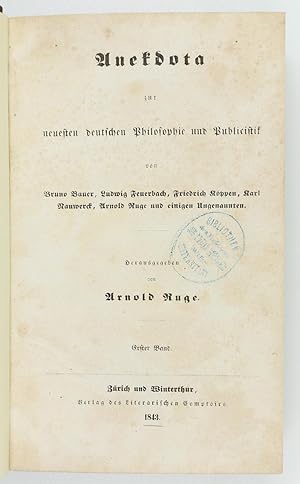

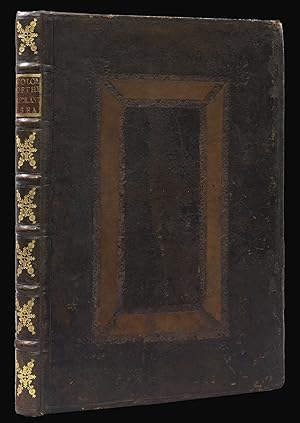

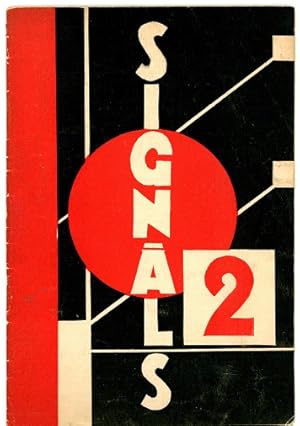

![Seller image for Anekdota zur neuesten deutschen Philosophie und Publicistik von Bruno Bauer, Ludwig Feuerbach, Friedrich Köppen, Karl Nauwerk, Arnold Ruge und einigen Ungenannten. 2 bde. [(Marx): Bemerkungen über die neueste preußische Censurinstruction. Von einem Rh. - [DEFINING THE ESSENCE OF REASON AS FREEDOM - MARX' DEBUT ARTICLE] for sale by Lynge & Søn ILAB-ABF](https://pictures.abebooks.com/inventory/md/md30657282153.jpg)
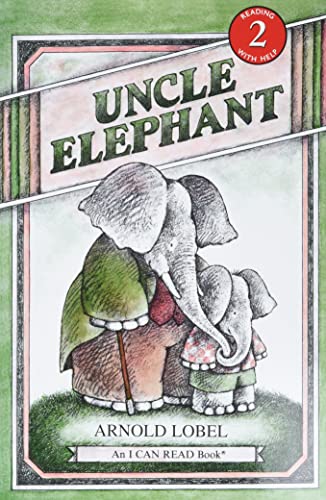
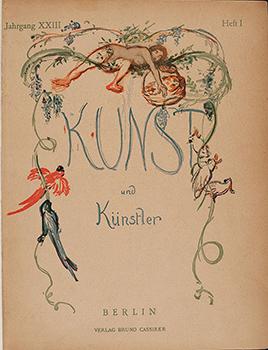
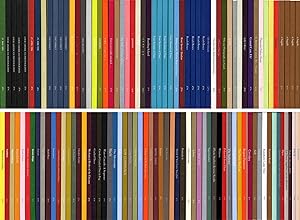
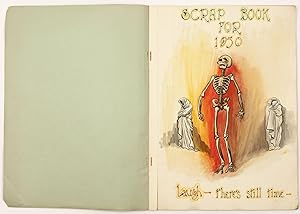
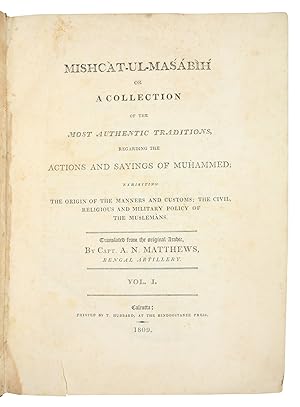

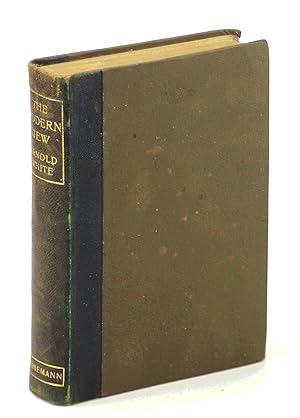
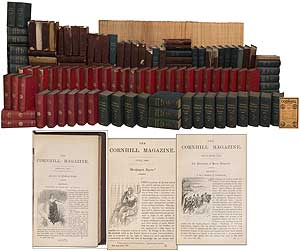
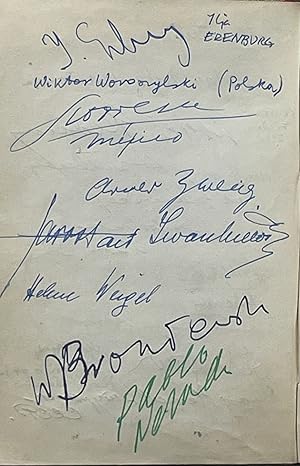
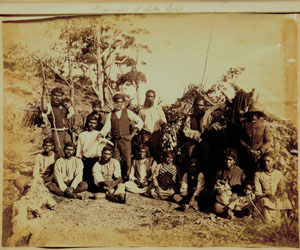
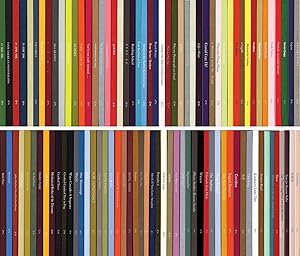
![Seller image for Dreimal sieben Gedichte aus Albert Girauds Pierrot Lunaire (Deutsch von Erich Otto Hartleben). Für eine Sprechstimme Klavier, Flöte (auch Piccolo), Klarinette (auch Baß=Klarinette), Geige (auch Bratsche) und Violoncell. (Melodramen) . Op. 21 Partitur. Numerierte orzugsausgabe auf Bütten. [Full score for voice and chamber orchestra] for sale by J & J LUBRANO MUSIC ANTIQUARIANS LLC](https://pictures.abebooks.com/inventory/md/md31535437297.jpg)
